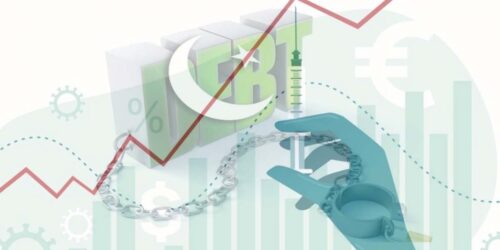Pakistan has been trapped in an unsustainable debt cycle for decades, with the most recent figures depicting the balance of the current account in deficit for the fourth successive month in March at a moderate $47 million, according to Pakistan’s central bank.
Pakistan’s Current Account Balance for the last 6 years is shown in the table below. This foreign currency deficit is currently being financed through loans and bonds.

Present Debt Profile
Pakistan’s debt level has increased significantly over time (figure below).

Short-term economic fixes will never amount to the sustainable growth needed for Pakistan’s economy, and the same is to be said of seeking IMF loans and bailouts. The country has relentlessly sought loans to achieve economic stability, which has naturally come with countless conditionalities.
IMF is the international lender of the last resort and only the countries faced with severe balance of payment difficulties are recommended to approach the IMF for emergency lending to secure a temporary relief.
However, Pakistan has approached IMF 22 times since 1965, as shown below. Thus, the country has been perpetually in the emergency ward of the IMF.

https://googleads.g.doubleclick.net/pagead/ads?client=ca-pub-2607420207717241&output=html&h=250&slotname=1434374822&adk=340752068&adf=250924054&pi=t.ma~as.1434374822&w=300&lmt=1621263727&psa=1&format=300×250&url=https%3A%2F%2Fwww.globalvillagespace.com%2Faptmas-policy-suggestions-to-break-the-begging-bowl%2F&flash=0&wgl=1&adsid=ChAI8MuNhQYQ0YnV-fjOuMkNEkwAvRzVSlfATUvp_s5ab3TkZNzn0llrl_DvI-_EY63I9-cVlGDWweYK4FB_sZ7CwNw_OthvucHJsPYj2ko70rY9tfaGAGVTQViNLPUq&uach=WyJXaW5kb3dzIiwiNi4xIiwieDg2IiwiIiwiOTAuMC40NDMwLjIxMiIsW11d&dt=1621368308547&bpp=5&bdt=4914&idt=1439&shv=r20210517&cbv=%2Fr20190131&ptt=9&saldr=aa&abxe=1&cookie=ID%3D122fbad5d2e47f3b-222112e412a700b2%3AT%3D1615584107%3ART%3D1615584107%3AR%3AS%3DALNI_MaXt49pVJZfvpXC3zyuzNNY3upjbw&prev_fmts=748×280%2C300x250%2C0x0%2C970x90%2C300x250&nras=1&correlator=2790194641538&frm=20&pv=1&ga_vid=790481492.1599167663&ga_sid=1621368310&ga_hid=245158693&ga_fc=0&u_tz=300&u_his=1&u_java=0&u_h=800&u_w=1280&u_ah=756&u_aw=1280&u_cd=24&u_nplug=3&u_nmime=4&adx=546&ady=3358&biw=1264&bih=633&scr_x=0&scr_y=864&eid=31060710%2C31060049%2C44743003%2C31061047&oid=3&psts=AGkb-H8L0N-os3ErIQJMadgS-CALgLmRHGamKGE9488fMZYTCeCYcWn9eMN5WEAvj7tlkkFRyDRiTGjIS41YAg%2CAGkb-H8OHYg1B_DpaL62dO289VKnAVXQQAk5qmK9VMZgfXlLt-4jl1kD5U5QLM1t86rx5hlxRYufhOwyoYSj&pvsid=4368317529059449&pem=146&eae=0&fc=896&brdim=0%2C0%2C0%2C0%2C1280%2C0%2C1280%2C756%2C1280%2C633&vis=1&rsz=%7C%7CoeEbr%7C&abl=CS&pfx=0&fu=0&bc=31&ifi=4&uci=a!4&btvi=4&fsb=1&xpc=xLRy8RfeVm&p=https%3A//www.globalvillagespace.com&dtd=20484
Debt Sustainability Analysis suggests that at the current level of GDP growth the country’s debt is not sustainable, that is, the Debt to GDP ratio will continue to increase; if the country grows at a rate hovering around 4.0%. (Source: PIDE RAPID Growth Strategy).
Meanwhile, we have neglected the local business community – particularly the export-oriented industry – which surely has the potential to steer sustainable economic growth as long as it is provided with basic policy support, and in particular, competitively priced energy. After direct raw material, energy is the highest input cost in the value chain.
Breaking the Cycle
Textile exports represent 62% of total exports and hence are the engine for the export growth policy for our country. Enhanced exports are the only tool to break the begging bowl and achieve real economic and political sovereignty.
Pakistan must target higher economic growth by prioritizing value-addition, particularly in the highly productive textile sector, where regionally competitive energy is the primary path towards real progress.
During periods where regionally competitive energy tariffs were given by the government, the export-oriented industries proved the critical role of these tariffs, by immediately showing an upward trend in production, reaching full capacity, as well as creating new jobs, new investment, and leading to all mills becoming operational.
Textile exports have increased substantially, with a 9 percent increase in the last 9 months of FY21 but have hit a ceiling in terms of industrial capacity availability.
The increase in export demonstrates the competitiveness of Pakistan’s exports – when inputs were provided at regionally competitive prices, the export potential was fully realized in spite of an unfavorable international environment created by the pandemic.





